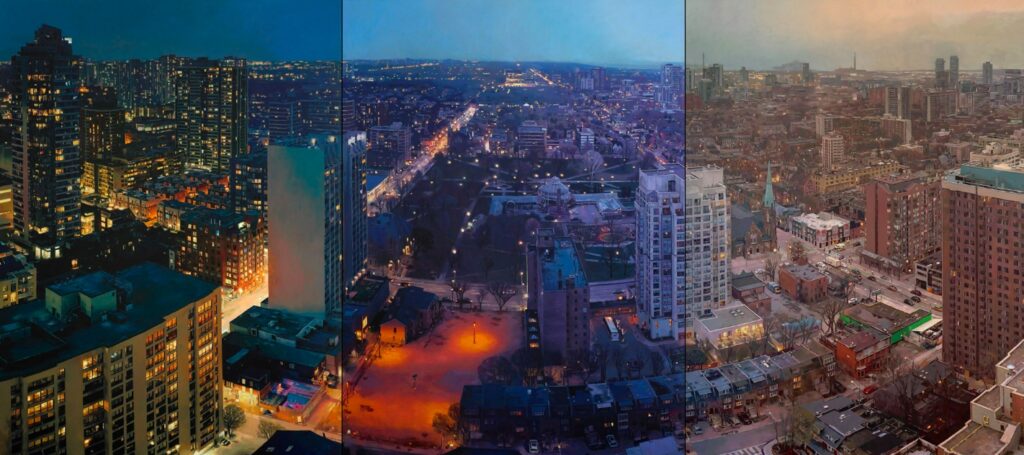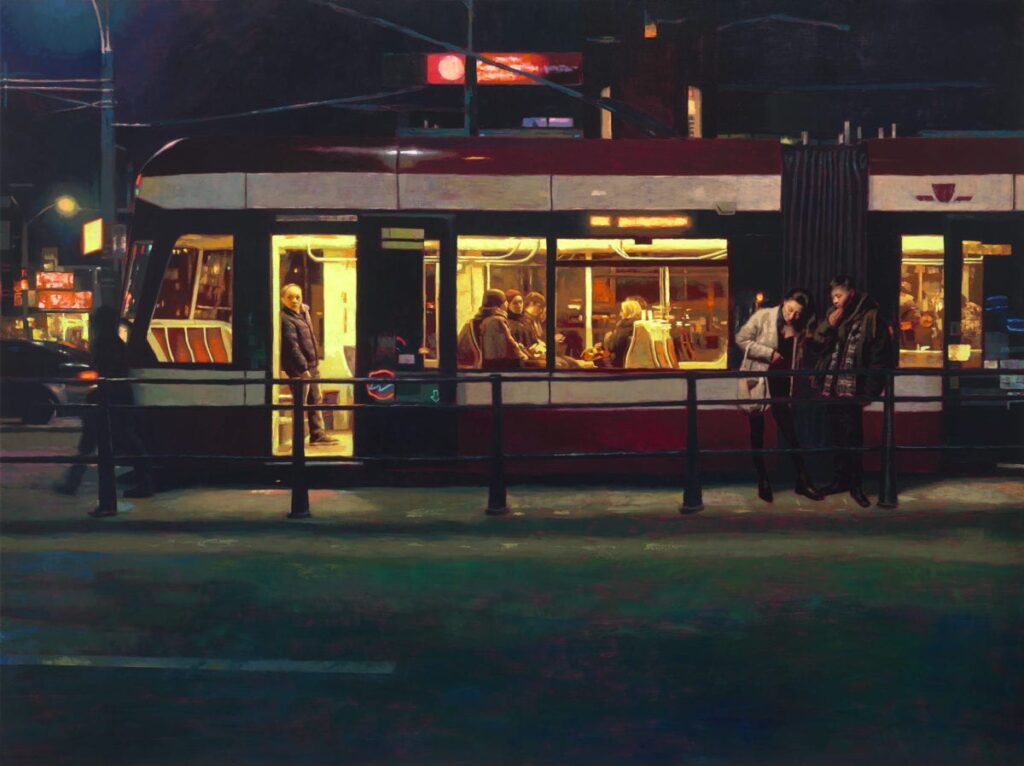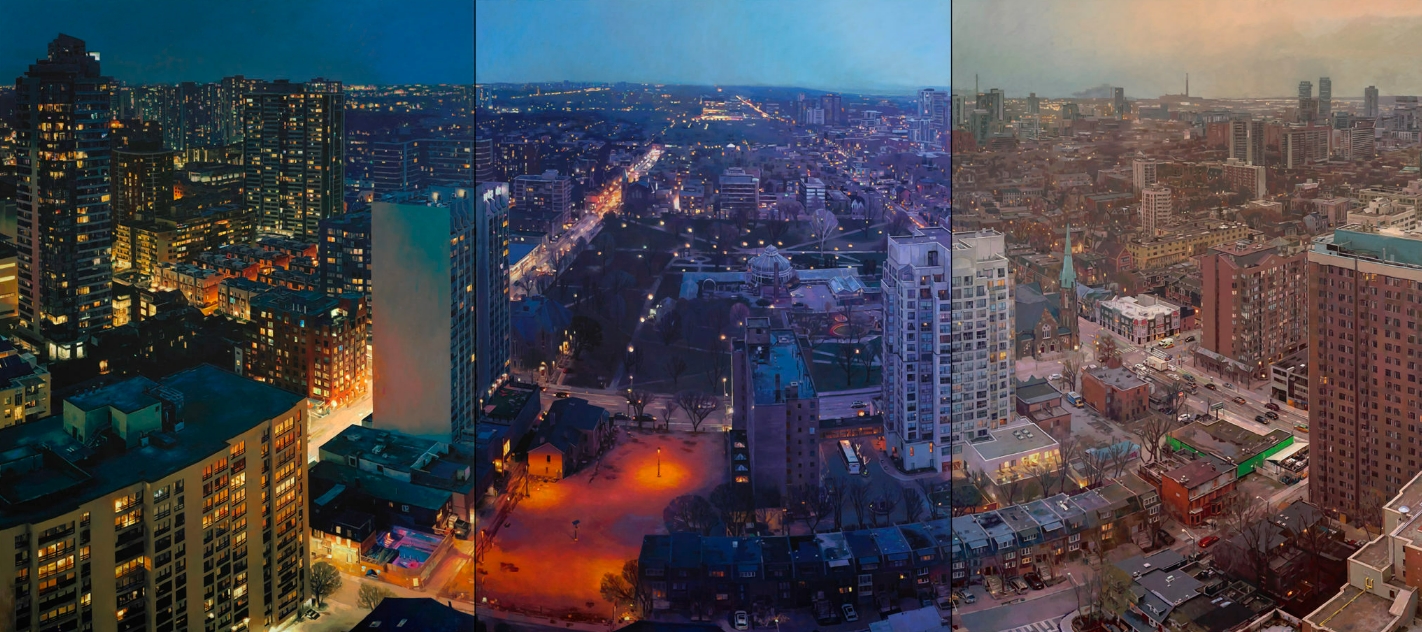
On display at the Nicholas Metivier Gallery
by Louise Nunn
When considering Canada’s contribution to the art world, it’s easy to identify household names like the Group of Seven or Quebec’s abstract painters les Automatistes. But spend some time, and a closer look will bring into the spotlight many individuals and voices across the country, working to move and connect people through art. Canada’s shores and inlands are dotted with abstract painters, landscape artists and talented realists committed to creating a niche for themselves in what is now a globalized art community. Gallery owner, Nicholas Metivier from Toronto’s Nicholas Metivier Gallery, has built a reputation on identifying top talent and helping artists develop their careers. Here, he introduces The Collection to three artists, each as unique as the country they call home: John Hartman, Landon Mackenzie, and Keita Morimoto.

John Hartman, Ian Brown above Go Home Bay, 2017, oil on linen, 60 x 66 in., courtesy of Nicholas Metivier Gallery, Toronto
John Hartman is a familiar face at the Metivier Gallery – and in fact at galleries across the country. He is best known for his large-scale, birds-eye-view landscapes that often incorporate people, ideas or objects into the landscape’s foreground. Hartman is an ardent believer that landscapes would be meaningless places without the many lives and stories that populate them, and it has been his mission to capture this vibrant life on every canvas. He does this through expressive texture, vibrant colour, and portraiture. “If you ask anybody about John Hartman, they’ll tell you that he’s a landscape painter,” Metivier says, “but his work is always inspired by the stories and the histories of the people of that place that he’s painting.”
Hartman paints at the intersection of figurative European work and Canadian landscape tradition. While Canadian painter David Milne explored aspects of figurative historical work before Hartman came on the scene – Metivier says he is “number one for Hartman in terms of influence,” – Metivier insists that Hartman has created a style all his own. “I can’t think of another Canadian painter that I could directly compare John’s style to His use of colour is crazy.”
Hartman gained national and international success with the exhibitions Big North and Cities. In his work, the artist is drawn, above all, to the natural beauty of Georgian Bay, where many of his own life experiences took place. “It is still, to this day, his favourite place in the world.” The Bay is the subject of his first exhibition of note, Painting the Bay (1993), and his 2004 exhibition Georgian Bay: Portraits from the Shoreline. He loves to capture the Bay through portraits of individuals, both famous and ordinary, who have worked on its shores. John’s next exhibition, High Water, opening at the Metivier Gallery this fall, will return the viewer to this much-loved landscape, while offering a fresh perspective. “You can expect the most autobiographical exhibition John has ever painted, which I find fascinating,” says Metivier. “It’s a shift for him. The landscapes are portrayed in quite a surreal, dynamic way, and part of it is the bird’s eye view, part of it’s the colour, and part of it…there’s this amazing energy to this work.”
Embedded within every masterpiece is this theme of story. The exhibit People and Place is the best introduction to this essential aspect of Hartman’s work. The original idea behind it, explains Metivier, was simply to paint Canadian authors in the places that were most meaningful to them – but the result has been an incredible 5-year project, a touring exhibition, and a book titled, Many Lives Mark This Place. Amongst the work, Ian Brown Above Go Home Bay, gives life to Ian Brown’s personal memories of time with his son at the familiar family site, Go Home Bay. Hartman brought story to the forefront by making the portrait larger than life on the canvas. “It was quite different than the previous work that John had been doing, and we wanted to talk to people about it in those terms.” According to Metivier, John looks back at People and Place as the inspiration for the autobiographical nature of High Water.

Landon Mackenzie, Time Machine, 2013-2019, oil and synthetic polymer on linen, 94 1/2 x 145 1/2 in., courtesy of Nicholas Metivier Gallery, Toronto
The next painter Metivier introduces is Landon Mackenzie – a renowned abstract painter who over her years in the industry has managed to create her own distinct style. The meaning of place seems to inspire Landon just as much as Hartman, but the result couldn’t be more different. “She’s a star, this lady,” says Metivier. “Travel is very important in Mackenzie’s practice. She’s inspired by history and maps. Mapping a place, and she reinterprets this through layers and through her own stories, impressions and understanding of place.” Makenzie has traveled across the country, living first in Toronto surrounded by her parents’ many artistic connections and finally settling on the west coast in Vancouver. She draws inspiration from her rich and varied experiences – from her first introduction to printmaking during university to her time as an academic liaison in Beijing on behalf of Emily Carr University – and she loves to blend her own life experiences with the told and untold histories of Canada.
Does Landon’s work fit into other abstract art being made across Canada? “I don’t think it does,” Metivier muses. “I think her voice is quite distinct and quite personal. I’m seeing a fair amount of contemporary younger painting, abstract painting that is quite formal. With Landon’s relationship to this country, her relationship to travel, it’s a soulful, personal narrative, although the works are abstract.” One example from her Particle Paintings exhibition at the Metivier Gallery is Neurotree. This painting brings together Landon’s motifs of geometric shape, neurological connections and mapping. The painting is split in two by a tree like formation, and across the canvas are cell like particles floating on a copper-colored background. “It’s a really great mix of micro and macro elements that talk about us and our world.”
Each of her paintings are journeys to Landon, who takes sometimes two or three years to complete a single work. In fact, her painting Time Machine took its name in part from the length of time it took to complete: nearly seven years. “The process is organic and intuitive,” says Metivier. “Each layer that she lays down responds to the previous one.” Landon’s canvases can be eight by 16 feet. She also has many works on paper, inspired from her earlier printmaking days. “It’s kind of Landon’s world, and people want to be a part of it. And it’s a fascinating world.” Landon was awarded the Governor General’s Award in Visual and Media Arts in 2017.

Keita Morimoto, Arrival, 2017, acrylic and oil on linen, 72 x 96 in., courtesy of Nicholas Metivier Gallery, Toronto
Keita Morimoto, an up and coming Japanese-Canadian artist, occupies an altogether different niche from his more experienced companions. Though he only graduated from OCAD in 2012, he is quickly finding success with his realist city paintings, becoming known for his warm-coloured depictions of Toronto. However, Metivier says, he did not start here. “When I took him on, he had these portraits of his friends set in [romantic painter John] Constable’s landscapes. [He was] really looking at going back to the classics, the Rembrandts, and I love [that] history.” There is a tell-tale nostalgic light in all of Keita’s city paintings, a use of light that traces back to these old European masters and also to the work of American realist painter Edward Hopper. “Hopper was so brilliant with light. And Keita is so brilliant with light.”
Keita is also bringing new light to old traditions by melding European classical painting styles with the modern and realist background of Toronto – something that Edward Hopper started in New York some decades earlier. Toronto has been Keita’s home since his high school days, and his favourable view of the city very literally colours his paintings. His most accomplished work to date, says Metivier, is the triptych – massive three-panel canvas – titled Garden of Light, which he created for this year’s exhibition of the same name. “It’s a view from an apartment building rooftop looking across Jarvis Street between Gerard and Wellesley looking east, and he photographed afternoon, evening and night.” Keita painted from these photographs the hues of each time of day – from deep blues and dusky morning light to his signature nostalgic oranges. “Each panel is eight feet by six feet. So, the length of the work in its entirety is 18 feet. It’s the largest work he’s ever completed, and it is the most accomplished. It’s quite brilliant.”
Keita seems to have a knack for really engaging long-time art connoisseurs with his work. “[My clients] would see [one of his city paintings] and immediately connect to it, it was fascinating.” Metivier says this is because of Keita’s “light and his use of colour. There’s a semantic to his work, which is impressive. And the semantic of course, is Toronto. He’s excited by Toronto.” Keita is just beginning what will hopefully be a long and successful career as an artist.
________________
The works of John Hartman, Landon Mackenzie, and Keita Morimoto are on display at the Nicholas Metivier Gallery in Old Toronto. For more information, visit metiviergallery.com
Featured Image: Keita Morimoto, Garden of Light, 2019, acrylic and oil on linen, 96 x 216 in., courtesy of Nicholas Metivier Gallery, Toronto

